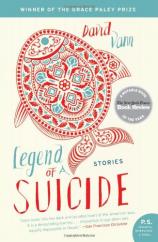Reading Group Guide
Discussion Questions
Legend of a Suicide: Stories

1. “Ichthyology” means ‘the study of fish.’ What do we learn from fish in this story? How do we read them? Why not just tell the story of the father directly?
2. What does the boy understand in “Rhoda”? What does the father understand? What does Rhoda understand?
3. The structure of “A Legend of Good Men” is a series of portraits, borrowing from Chaucer’s Legend of Good Women and the tradition of writing about saints’ lives (and this is the meaning of the word “Legend” in the title of the book also: a series of portraits). Why do we need to hear about all these men? What’s the point?
4. The enormous change in the middle of the novella “Sukkwan Island” came as a complete surprise to the author. He didn’t know what was going to happen until he was partway through writing that sentence. What’s the significance of the event?
5. What role does wilderness play in “Sukkwan Island”?
6. What is Roy searching for in “Ketchikan”? What does he find?
7. “The Higher Blue” repeats the dramatic structure of “Ichthyology” but in a fabulist riff which provides an epilogue to the book. The story is set in Fairbanks, where the author’s father actually killed himself. Why does the boy hide away in the cabinet?
8. Is this book closer to being a story collection or a novel? Do the stories have to be read together and in this order to gain their full meaning?
9. Why does the style vary from story to story?
10. Is it possible to understand why someone has committed suicide?
Legend of a Suicide: Stories
- Publication Date: March 16, 2010
- Paperback: 272 pages
- Publisher: Harper Perennial
- ISBN-10: 0061875848
- ISBN-13: 9780061875847








